Mapping the Impact of Spontaneous Streetscape Features on Social Sensing in the Old City of Quanzhou, China: Based on Multisource Data and Machine Learning
Abstract
1. Introduction
- (1)
- How can we combine the latest practices of visual perception methods and the nature of spontaneous streetscape elements?
- (2)
- What are the spatial distribution characteristics of the spontaneous streetscape elements at an intraurban scale?
- (3)
- What are the impacts of the features on diversified social sensing?
- (1)
- Overall, the spontaneous streetscape features have a certain similarity in the impact on both dimensions of social sensing in Quanzhou, with significant clustering and transitional trends and strong spatial heterogeneity.
- (2)
- Specifically, the spontaneous streetscape elements can be divided into three types, given the differentiated roles of significantly positive, negative, and polarizing impacts on both types of social sensing.
2. Literature Review
2.1. Nature of the Spontaneous Streetscape and the Elements
2.2. Image Identification of Micro-Scale Elements in Street Studies
2.3. Data-Driven Social Sensing and Its Methods
3. Materials and Methods
3.1. Study Area
3.2. Data Acquisition and Methods
3.2.1. Mobile Collection of Street View Images
3.2.2. Classification of Spontaneous Streetscape Elements
3.2.3. Machine Learning Model Training
3.2.4. Social Sensing Data Processing
3.2.5. Multiple Regression Models
4. Results
4.1. Features of Spontaneous Streetscape Element Distribution
4.2. Spatial Distribution of Social Sensing
4.3. Impact of the Spontaneous Streetscape Features on Social Sensing
4.3.1. Performance Comparison of Multiple Regression Models
4.3.2. Impact of Spontaneous Streetscape Features on Economic Vitality
Dianping Merchant Quantity as the Proxy of Economic Vitality
Dianping Consumer Comments as the Proxy of Economic Vitality
4.3.3. Impact of Spontaneous Streetscape Features on Social Media Perception
Weibo Check-In Quantity as a Proxy of Social Media Perception
Weibo Sentiment Index as the Proxy of Social Media Perception
5. Discussion and Conclusions
- (1)
- Overall, the spontaneous streetscape features have a certain similarity in terms of their impact on both dimensions of social sensing in Quanzhou, indicating significant clustering and transitional trends and strong spatial heterogeneity.
- (2)
- Specifically, the spontaneous streetscape elements can be divided into three categories, given their differentiated roles of significantly positive, negative, and polarizing impacts on the social sensing results.
Author Contributions
Funding
Data Availability Statement
Conflicts of Interest
References
- Shang, W.; He, C.; Lv, S. Sustainable Renewal of Spontaneous Spatial Characteristics of a Historical–Cultural District: A Case Study of Tanhualin, Wuhan, China. Sustainability 2023, 15, 2038. [Google Scholar] [CrossRef]
- Zhang, W.; Xin, J. Green Spaces and the Spontaneous Renewal of Historic Neighborhoods: A Case Study of Beijing’s Dashilar Community. Sustainability 2023, 15, 16566. [Google Scholar] [CrossRef]
- Hartmann, T.; Jehling, M. From diversity to justice-Unraveling pluralistic rationalities in urban design. Cities 2019, 91, 58–63. [Google Scholar] [CrossRef]
- Baharoglu, D.; Leitmann, J. Coping Strategies for Infrastructure: How Turkey’s Spontaneous Settlements Operate in the Absence of Formal Rules. Habitat Int. 1998, 22, 115–135. [Google Scholar] [CrossRef]
- Itma, M.; Monna, S. Sustainable Housing Design Potentials in Palestine: A Focus on the Spontaneous Urban Design Form. J. Urban Plan. Dev. 2024, 150, 04023050. [Google Scholar] [CrossRef]
- Li, J.; Wang, F.; Wuzhati, S.; Wen, B. Urban or village residents? A case study of the spontaneous space transformation of the forced upstairs farmers’ community in Beijing. Habitat Int. 2016, 56, 136–146. [Google Scholar] [CrossRef]
- Cozzolino, S. On the spontaneous beauty of cities: Neither design nor chaos. Urban Des. Int. 2022, 27, 43–52. [Google Scholar] [CrossRef]
- Wang, F.; Liu, X.; Zhang, Y. Spatial landscape transformation of Beijing compounds under residents’ willingness. Habitat Int. 2016, 55, 167–179. [Google Scholar] [CrossRef]
- Shen, J.; Lin, L. State-sponsored and spontaneous urbanization in Fujian province of China, 1982–2010. Cities 2017, 60, 420–427. [Google Scholar] [CrossRef]
- Zhou, L.; Wang, T. Social media: A new vehicle for city marketing in China. Cities 2014, 37, 27–32. [Google Scholar] [CrossRef]
- Li, K.; Lin, Y. Exploring the Correlation between Streetscape and Economic Vitality Using Machine Learning: A Case Study in the Old Urban District of Xuzhou, China. ISPRS Int. J. Geo-Inf. 2023, 12, 267. [Google Scholar] [CrossRef]
- Ali Qalati, S.; Li, W.; Ahmed, N.; Ali Mirani, M.; Khan, A. Examining the Factors Affecting SME Performance: The Mediating Role of Social Media Adoption. Sustainability 2021, 13, 75. [Google Scholar] [CrossRef]
- Zhang, Z.; Wang, X.; Zhu, G.; Zhang, W.; Chen, L.; Fang, K.; Xie, Y.; Shen, M.; Furuya, N. A micro-scale study on the spontaneous spatial improvement of in-between spaces in Chinese traditional districts considering the relationship between modifications and encroachment. J. Asian Archit. Build. 2023, 22, 783–801. [Google Scholar] [CrossRef]
- Jeon, J.; Woo, A. Deep learning analysis of street panorama images to evaluate the streetscape walkability of neighborhoods for subsidized families in Seoul, Korea. Landsc. Urban Plan. 2023, 230, 104631. [Google Scholar] [CrossRef]
- Chen, S.; Biljecki, F. Automatic assessment of public open spaces using street view imagery. Cities 2023, 137, 104329. [Google Scholar] [CrossRef]
- Larkin, A.; Gu, X.; Chen, L.; Hystad, P. Predicting perceptions of the built environment using GIS, satellite and street view image approaches. Landsc. Urban Plan. 2021, 216, 104257. [Google Scholar] [CrossRef]
- Koo, B.W.; Guhathakurta, S.; Botchwey, N.; Hipp, A. Can good microscale pedestrian streetscapes enhance the benefits of macroscale accessible urban form? An automated audit approach using Google street view images. Landsc. Urban Plan. 2023, 237, 104816. [Google Scholar] [CrossRef]
- Gong, Z.; Ma, Q.; Kan, C.; Qi, Q. Classifying Street Spaces with Street View Images for a Spatial Indicator of Urban Functions. Sustainability 2019, 11, 6424. [Google Scholar] [CrossRef]
- Huang, Y.; Zhang, F.; Gao, Y.; Tu, W.; Duarte, F.; Ratti, C.; Guo, D.; Liu, Y. Comprehensive urban space representation with varying numbers of street-level images. Comput. Environ. Urban Syst. 2023, 106, 102043. [Google Scholar] [CrossRef]
- He, J.; Zhang, J.; Yao, Y.; Li, X. Extracting human perceptions from street view images for better assessing urban renewal potential. Cities 2023, 134, 104189. [Google Scholar] [CrossRef]
- Ma, X.; Ma, C.; Wu, C.; Xi, Y.; Yang, R.; Peng, N.; Zhang, C.; Ren, F. Measuring human perceptions of streetscapes to better inform urban renewal: A perspective of scene semantic parsing. Cities 2021, 110, 103086. [Google Scholar] [CrossRef]
- Rui, J. Measuring streetscape perceptions from driveways and sidewalks to inform pedestrian-oriented street renewal in Düsseldorf. Cities 2023, 141, 104472. [Google Scholar] [CrossRef]
- Lynch, K. The Image of the City; The MIT Press: Cambridge, MA, USA, 1960. [Google Scholar]
- Dunkel, A. Visualizing the perceived environment using crowdsourced photo geodata. Landsc. Urban Plan. 2015, 142, 173–186. [Google Scholar] [CrossRef]
- Huang, J.; Obracht-Prondzynska, H.; Kamrowska-Zaluska, D.; Sun, Y.; Li, L. The image of the City on social media: A comparative study using “Big Data” and “Small Data” methods in the Tri-City Region in Poland. Landsc. Urban Plan. 2021, 206, 103977. [Google Scholar] [CrossRef]
- Zahnow, R.; Verrier, J.; Hames, S.; Corcoran, J. Mapping and measuring neighbourhood social media groups. The case of facebook. Appl. Geogr. 2024, 172, 103415. [Google Scholar] [CrossRef]
- Jia, J.; Zhang, X.; Zhang, W. Between place attachment and urban planning in Jinan: Does environmental quality affect human perception in a developing country context? Land Use Pol. 2025, 148, 107384. [Google Scholar] [CrossRef]
- Kim, S.; Woo, A. Streetscape and business survival: Examining the impact of walkable environments on the survival of restaurant businesses in commercial areas based on street view images. J. Transp. Geogr. 2022, 105, 103480. [Google Scholar] [CrossRef]
- Zhang, A.; Li, W.; Wu, J.; Lin, J.; Chu, J.; Xia, C. How can the urban landscape affect urban vitality at the street block level? A case study of 15 metropolises in China. Environ. Plan. B Urban Anal. City Sci. 2021, 48, 1245–1262. [Google Scholar] [CrossRef]
- Zhang, F.; Zhou, B.; Liu, L.; Liu, Y.; Fung, H.H.; Lin, H.; Ratti, C. Measuring human perceptions of a large-scale urban region using machine learning. Landsc. Urban Plan. 2018, 180, 148–160. [Google Scholar] [CrossRef]
- Danish, M.; Labib, S.M.; Ricker, B.; Helbich, M. A citizen science toolkit to collect human perceptions of urban environments using open street view images. Comput. Environ. Urban Syst. 2025, 116, 102207. [Google Scholar] [CrossRef]
- Jacobs, J. The Death and Life of Great American Cities; Vintage Book Company: New York, NY, USA, 1961. [Google Scholar]
- Cambridge Dictionary. Available online: https://dictionary.cambridge.org/dictionary/english/spontaneity (accessed on 19 March 2025).
- Yuan, Y.; Wang, R.; Niu, T.; Liu, Y. Using street view images and a geographical detector to understand how street-level built environment is associated with urban poverty: A case study in Guangzhou. Appl. Geogr. 2023, 156, 102980. [Google Scholar] [CrossRef]
- Wang, X.; Liu, Y.; Yao, Y.; Zhou, S.; Zhu, Q.; Liu, M.; Helbich, M. Adolescents’ environmental perceptions mediate associations between streetscape environments and active school travel. Transp. Res. Part D Transp. Environ. 2023, 114, 103549. [Google Scholar] [CrossRef]
- Ye, Y.; Zeng, W.; Shen, Q.; Zhang, X.; Lu, Y. The visual quality of streets: A human-centred continuous measurement based on machine learning algorithms and street view images. Environ. Plan. B Urban Anal. City Sci. 2019, 46, 1439–1457. [Google Scholar] [CrossRef]
- Koo, B.W.; Hwang, U.; Guhathakurta, S. Streetscapes as part of servicescapes: Can walkable streetscapes make local businesses more attractive? Comput. Environ. Urban Syst. 2023, 106, 102030. [Google Scholar] [CrossRef]
- Lee, J.; Kim, D.; Park, J. A Machine Learning and Computer Vision Study of the Environmental Characteristics of Streetscapes That Affect Pedestrian Satisfaction. Sustainability 2022, 14, 5730. [Google Scholar] [CrossRef]
- Woo, A.; Han, J.; Shin, H.; Lee, S. Economic benefits of urban streetscapes: Analyzing the interrelationships between visual street environments and single-family property values in Seoul, Korea. Appl. Geogr. 2024, 163, 103182. [Google Scholar] [CrossRef]
- Yue, H.; Liu, L.; Xu, C.; Song, G.; Chen, J.; He, L.; Duan, L. Investigating the diurnal effects of on-street population and streetscape physical environment on street theft crime: A machine learning and negative binomial regression approach using street view images. Appl. Geogr. 2024, 163, 103194. [Google Scholar] [CrossRef]
- Liu, Y.; Liu, Y. Detecting the city-scale spatial pattern of the urban informal sector by using the street view images: A street vendor massive investigation case. Cities 2022, 131, 103959. [Google Scholar] [CrossRef]
- Kim, J.; Park, J.; Lee, J.; Jang, K.M. Examining the socio-spatial patterns of bus shelters with deep learning analysis of street-view images: A case study of 20 cities in the U.S. Cities 2024, 132, 104852. [Google Scholar] [CrossRef]
- Cinnamon, J.; Gaffney, A. Do-It-Yourself Street Views and the Urban Imaginary of Google Street View. J. Urban Technol. 2021, 29, 95–116. [Google Scholar] [CrossRef]
- Williams, S.; Ahn, C.; Gunc, H.; Ozgirin, E.; Pearce, M.; Xiong, Z. Evaluating sensors for the measurement of public life: A future in image processing. Environ. Plan. B Urban Anal. City Sci. 2019, 46, 1534–1548. [Google Scholar] [CrossRef]
- Liu, Y.; Liu, X.; Gao, S.; Gong, L.; Kang, C.; Zhi, Y.; Chi, G.; Shi, L. Social Sensing: A New Approach to Understanding Our Socioeconomic Environments. Ann. Assoc. Am. Geogr. 2015, 105, 512–530. [Google Scholar] [CrossRef]
- Liao, C.; Brown, D.; Fei, D.; Long, X.; Chen, D.; Che, S. Big data-enabled social sensing in spatial analysis: Potentials and pitfalls. Trans. GIS 2018, 22, 1351–1371. [Google Scholar] [CrossRef]
- Liu, Y. Geographical Big Data and Social Sensing; Science Press: Beijing, China, 2023. [Google Scholar]
- Peng, X.; Li, Y.; Si, Y.; Xu, L.; Liu, X.; Li, D.; Liu, Y. A social sensing approach for everyday urban problem-handling with the 12345-complaint hotline data. Comput. Environ. Urban Syst. 2022, 94, 101790. [Google Scholar] [CrossRef]
- Li, C.; Huang, Y.; Shen, Y.; Xu, L. Spatiotemporal patterns and mechanisms of street vending from the social sensing perspective: A comparison between law-enforcement reported and residents complain events. Cities 2022, 124, 103597. [Google Scholar] [CrossRef]
- Ghermandi, A.; Sinclair, M. Passive crowdsourcing of social media in environmental research: A systematic map. Glob. Environ. Change 2019, 55, 36–47. [Google Scholar] [CrossRef]
- Zhang, Y.; Kwan, M.-P.; Yu, B.; Liu, Y.; Song, L.; Chen, N. Quantitative Identification of Mixed Urban Functions: A Probabilistic Approach Based on Physical and Social Sensing Data. Trans. GIS 2025, 29, e13272. [Google Scholar] [CrossRef]
- UNESCO World Heritage Center. Quanzhou: Emporium of the World in Song-Yuan China. Available online: https://whc.unesco.org/en/list/1561 (accessed on 22 March 2025).
- Quanzhou Municipal People’s Government. Available online: https://www.quanzhou.gov.cn/zfb/xxgk/zfxxgkzl/qzdt/qzyw/202112/t20211205_2664783.htm (accessed on 22 March 2025).
- Li, Y.; Yabuki, N.; Fukuda, T. Exploring the association between street built environment and street vitality using deep learning methods. Sustain. Cities Soc. 2022, 79, 103656. [Google Scholar] [CrossRef]
- Jiang, J.; Wang, J.; Yao, H.; Zhang, Z.; Xu, Z. Revealing the mobile sensing powers of semi-random and deterministic “drive-by” vehicle fleets. Trans. GIS 2024, 28, 2–22. [Google Scholar] [CrossRef]
- Birenboim, A.; Helbich, M.; Kwan, M.-P. Advances in portable sensing for urban environments: Understanding cities from a mobility perspective. Comput. Environ. Urban Syst. 2021, 88, 101650. [Google Scholar] [CrossRef]
- Redmon, J.; Divvala, S.; Girshick, R.; Farhadi, A. You Only Look Once: Unified, Real-Time Object Detection. In Proceedings of the 2016 IEEE Conference on Computer Vision and Pattern Recognition (CVPR), Las Vegas, NV, USA, 27–30 June 2016. [Google Scholar] [CrossRef]
- Ye, Y.; Li, D.; Liu, X. How block density and typology affect urban vitality: An exploratory analysis in Shenzhen. China. Urban Geogr. 2018, 39, 631–652. [Google Scholar] [CrossRef]
- Long, Y.; Huang, C. Does block size matter? The impact of urban design on economic vitality for Chinese cities. Environ. Plan. B Urban Anal. City Sci. 2019, 46, 406–422. [Google Scholar] [CrossRef]
- Yang, D.; Wang, X.; Han, R. Nonlinear and Synergistic Effects of the Built Environment on Street Vitality: The Case of Shenyang. Urban Plan. Forum 2023, 5, 93–1002. [Google Scholar] [CrossRef]
- Fotheringham, A.S.; Yang, W.; Kang, W. Multiscale Geographically Weighted Regression (MGWR). Ann. Assoc. Am. Geogr. 2017, 107, 1247–1265. [Google Scholar] [CrossRef]
- Xia, C.; Zhang, A.; Yeh, A.G.O. The Varying Relationships between Multidimensional Urban Form and Urban Vitality in Chinese Megacities: Insights from a Comparative Analysis. Ann. Assoc. Am. Geogr. 2022, 112, 141–166. [Google Scholar] [CrossRef]
- Chen, Y.; Yu, B.; Shu, B.; Yang, L.; Wang, R. Exploring the spatiotemporal patterns and correlates of urban vitality: Temporal and spatial heterogeneity. Sustain. Cities Soc. 2023, 91, 104440. [Google Scholar] [CrossRef]
- Hou, C.; Zhang, F.; Kang, Y.; Gao, S.; Li, Y.; Duarte, F.; Li, S. Transferred Bias Uncovers the Balance Between the Development of Physical and Socioeconomic Environments of Cities. Ann. Assoc. Am. Geogr. 2025, 115, 148–166. [Google Scholar] [CrossRef]
- Zhang, F.; Salazar-Miranda, A.; Duarte, F.; Vale, L.; Hack, G.; Chen, M.; Liu, Y.; Batty, M.; Ratti, C. Urban Visual Intelligence: Studying Cities with Artificial Intelligence and Street-Level Imagery. Ann. Assoc. Am. Geogr. 2024, 114, 876–897. [Google Scholar] [CrossRef]
- Maas, P.R. Towards a Theory of Urban Vitality. Doctor’s Thesis, University of British Columbia, Vancouver, BC, Canada, 1984. [Google Scholar]
- Zikirya, B.; He, X.; Li, M.; Zhou, C. Urban Food Takeaway Vitality: A New Technique to Assess Urban Vitality. Int. J. Environ. Res. Public Health 2021, 18, 3578. [Google Scholar] [CrossRef]
- Shanghai Municipal Bureau of Planning and Land Resources Management, Shanghai Municipal Commission of Transport, Shanghai Urban Planning and Design Institute. Shanghai Street Design Guidelines; Tongji University Press: Shanghai, China, 2016. [Google Scholar]

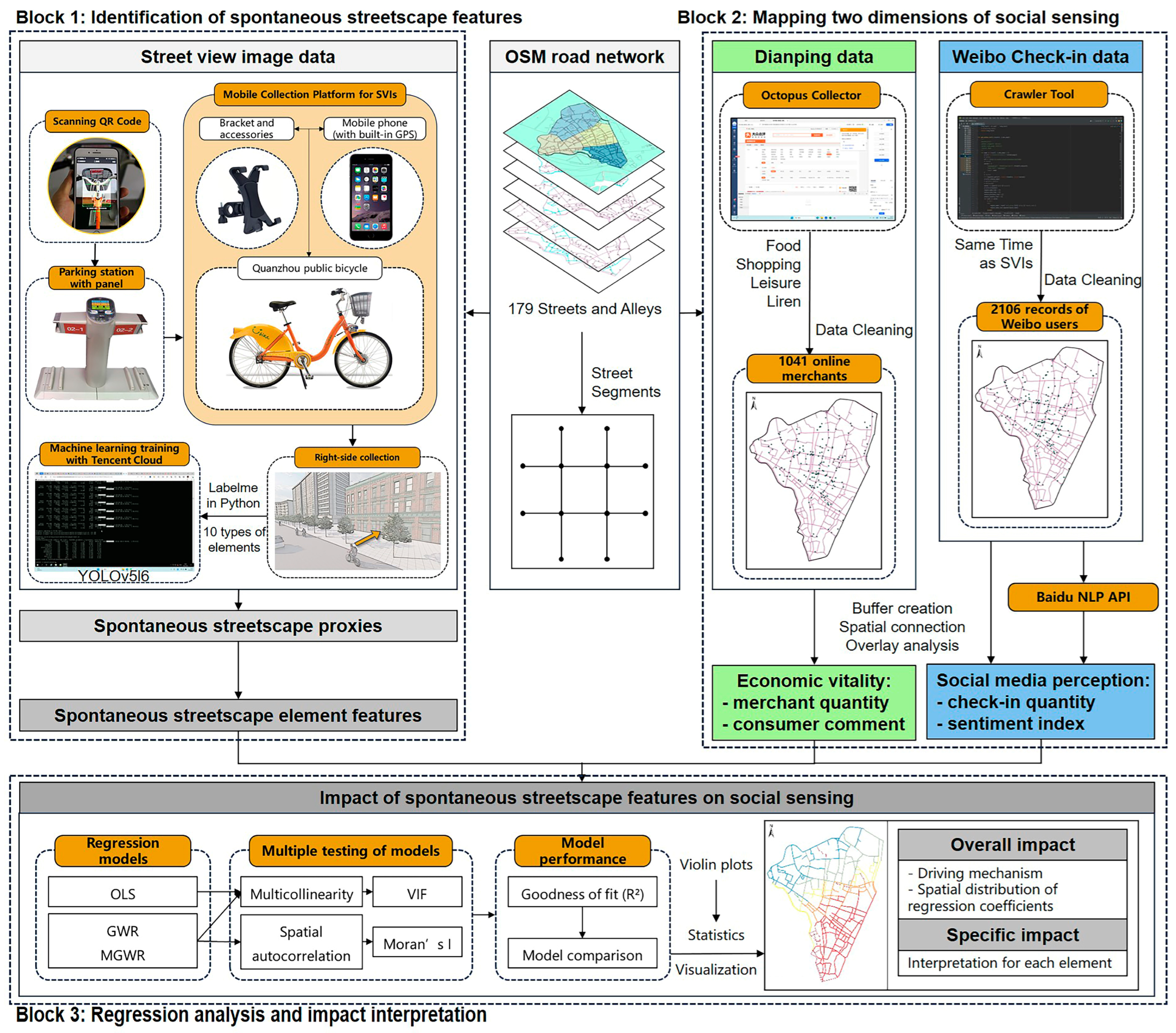
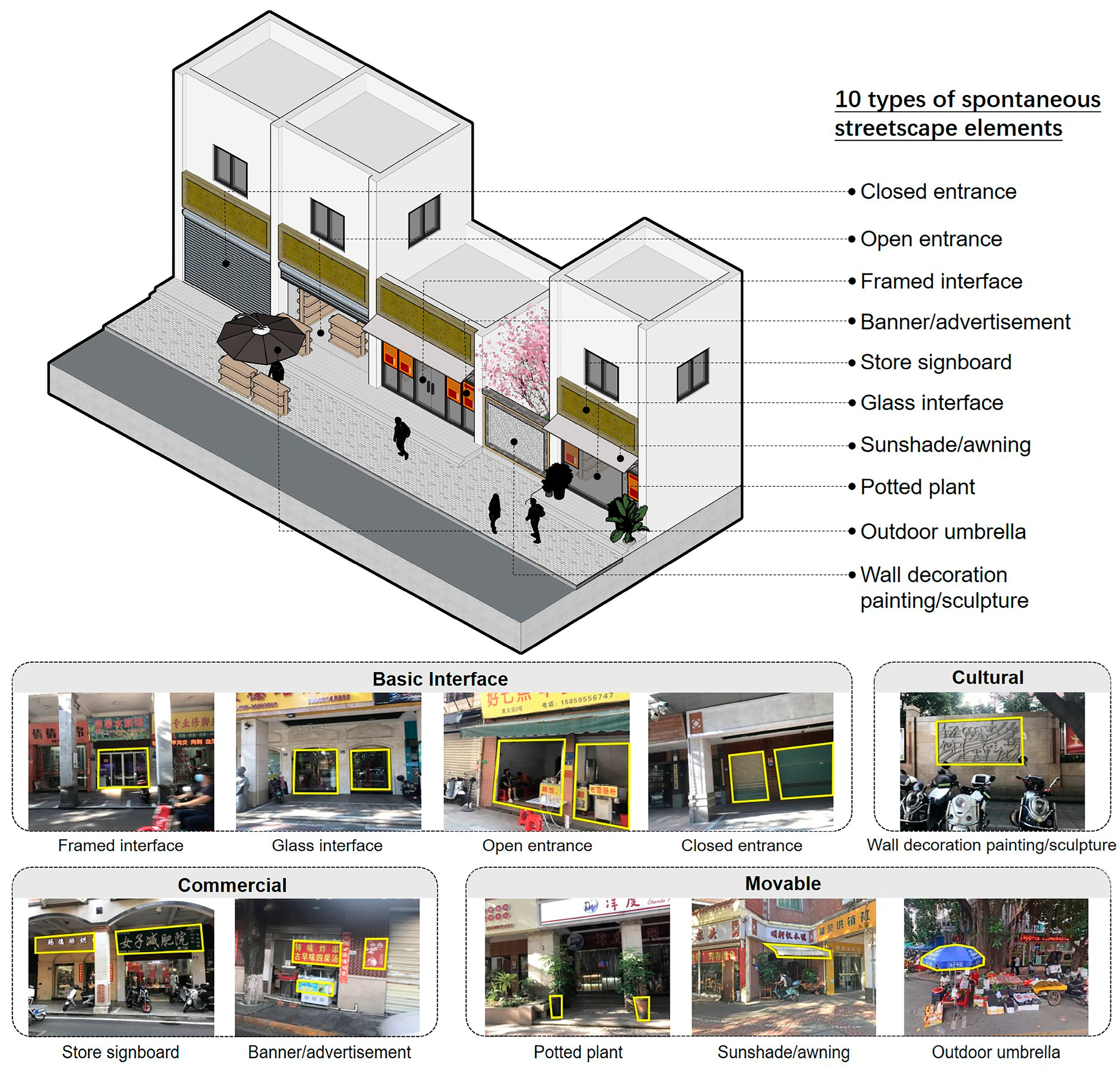
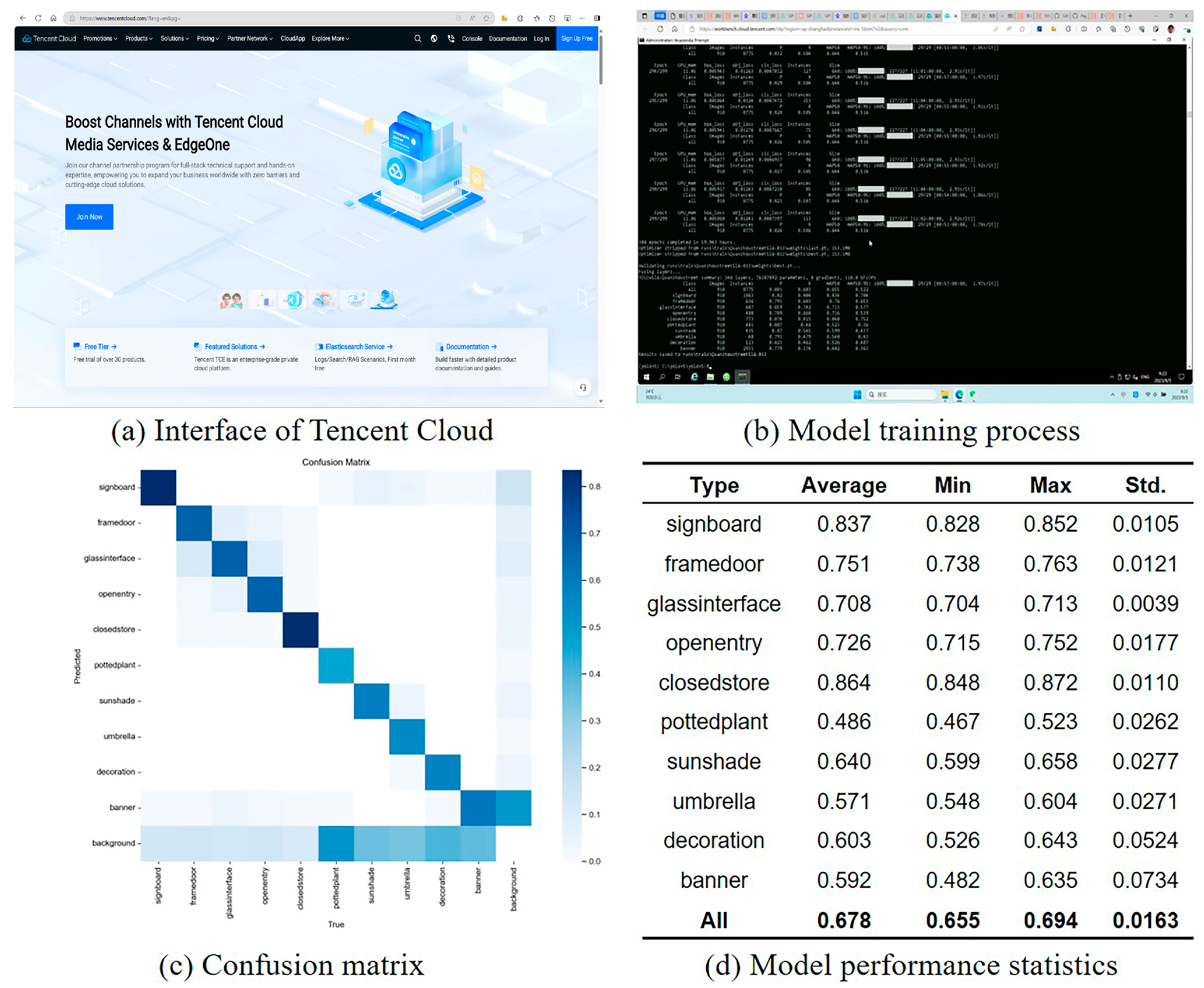
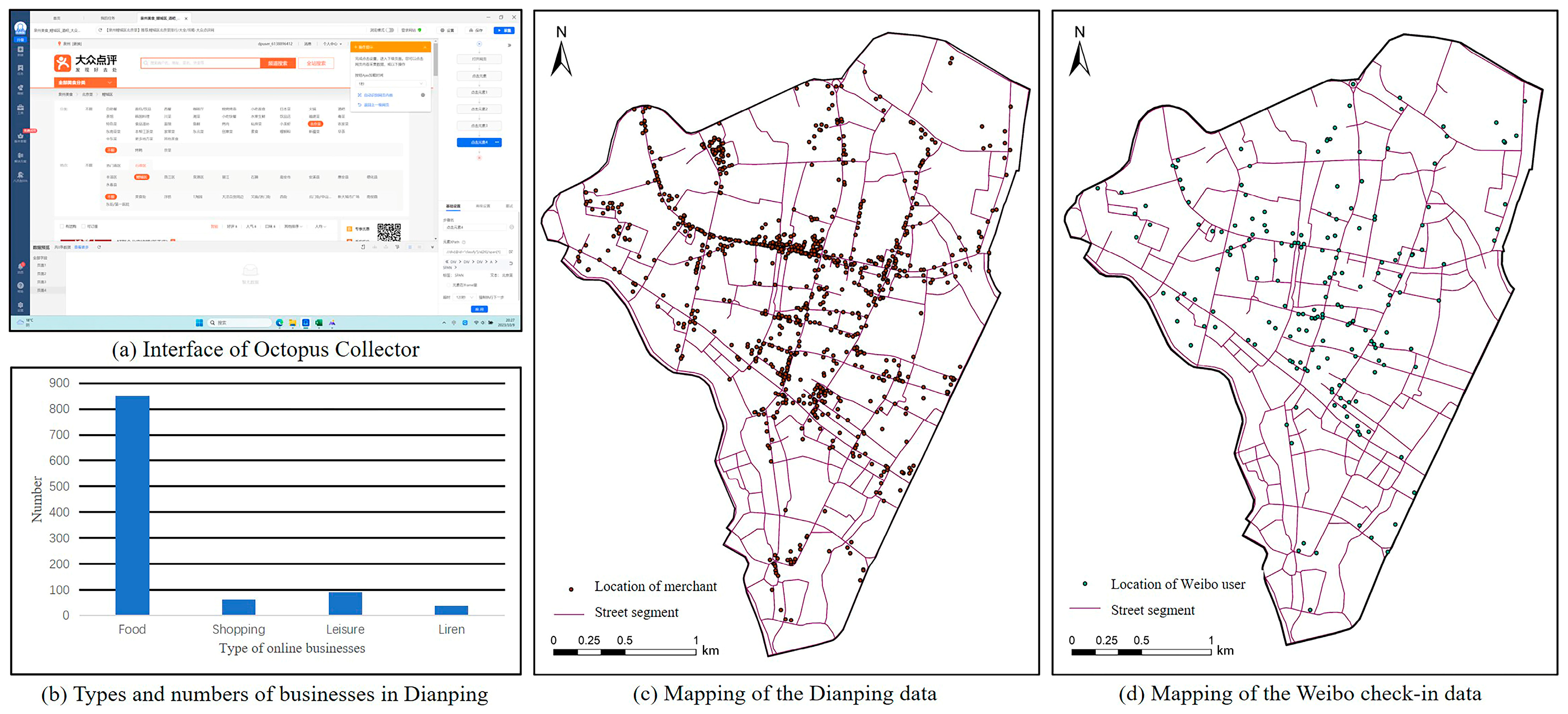
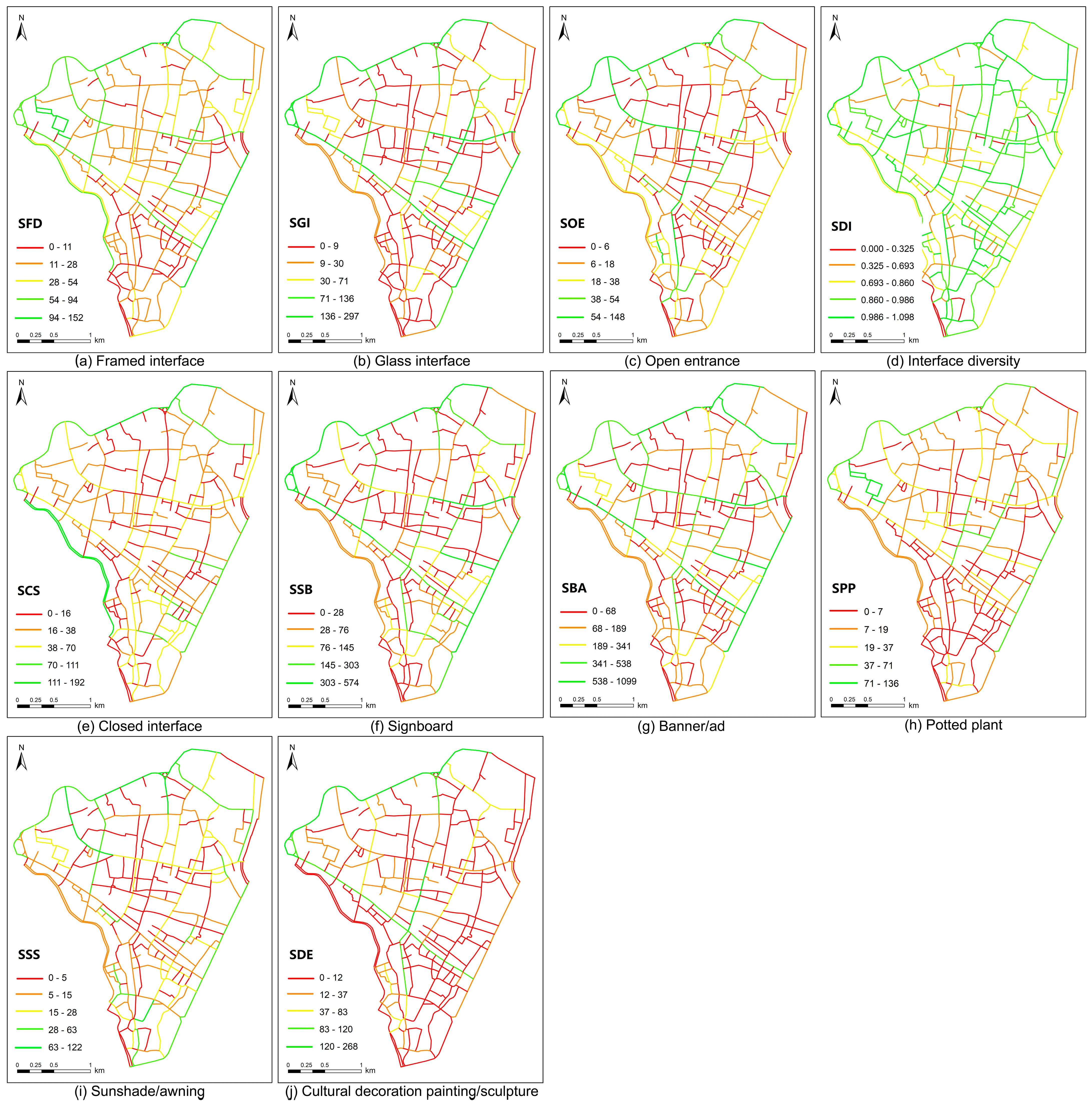
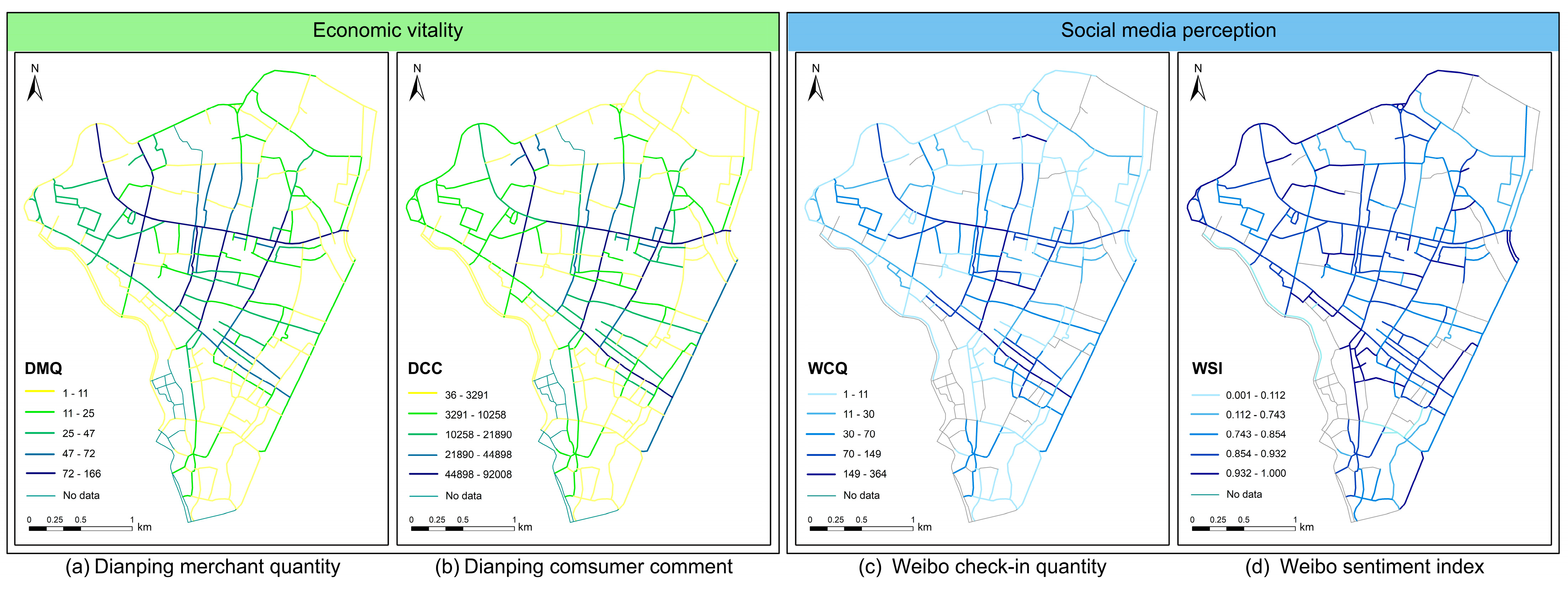
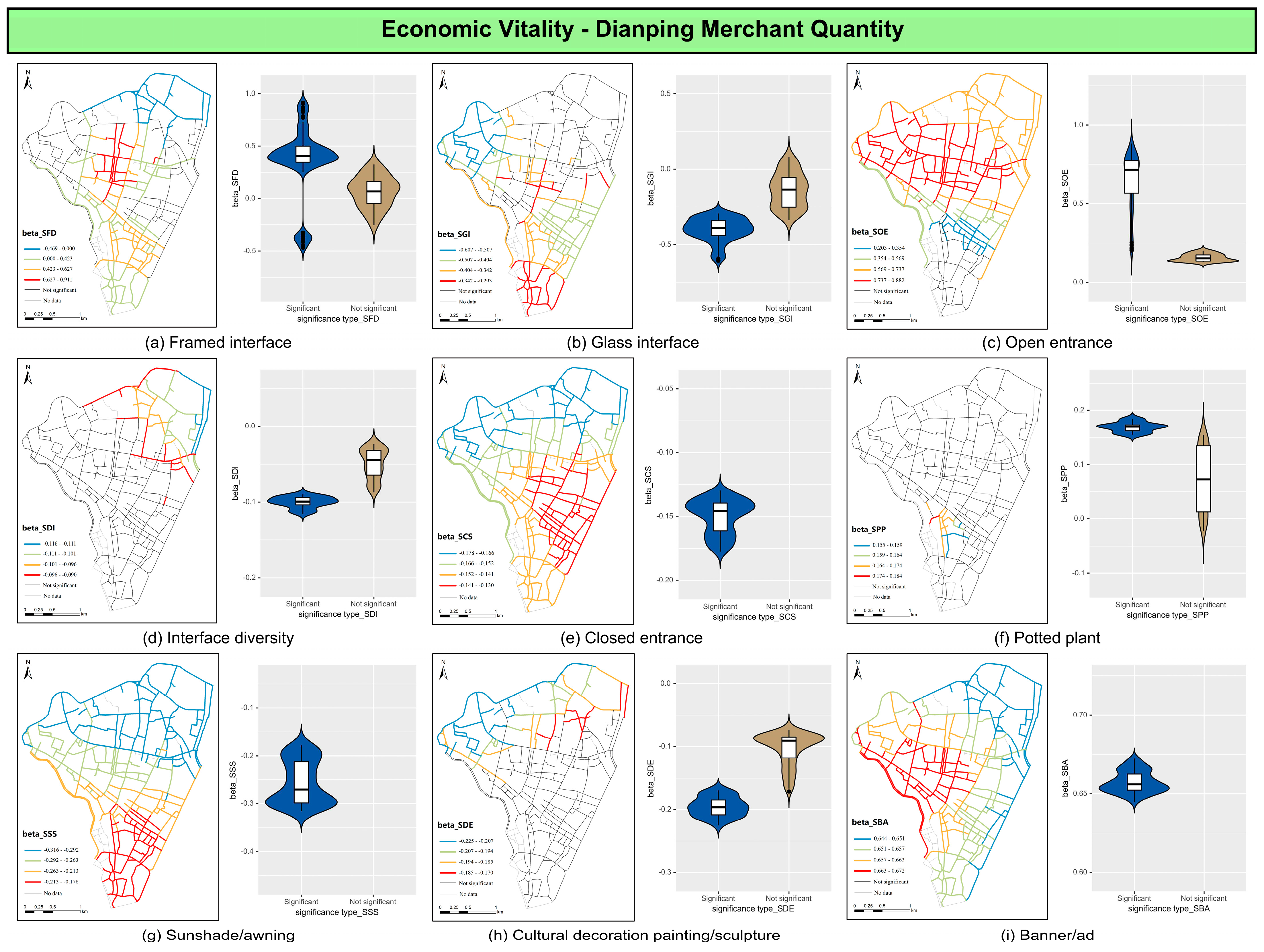
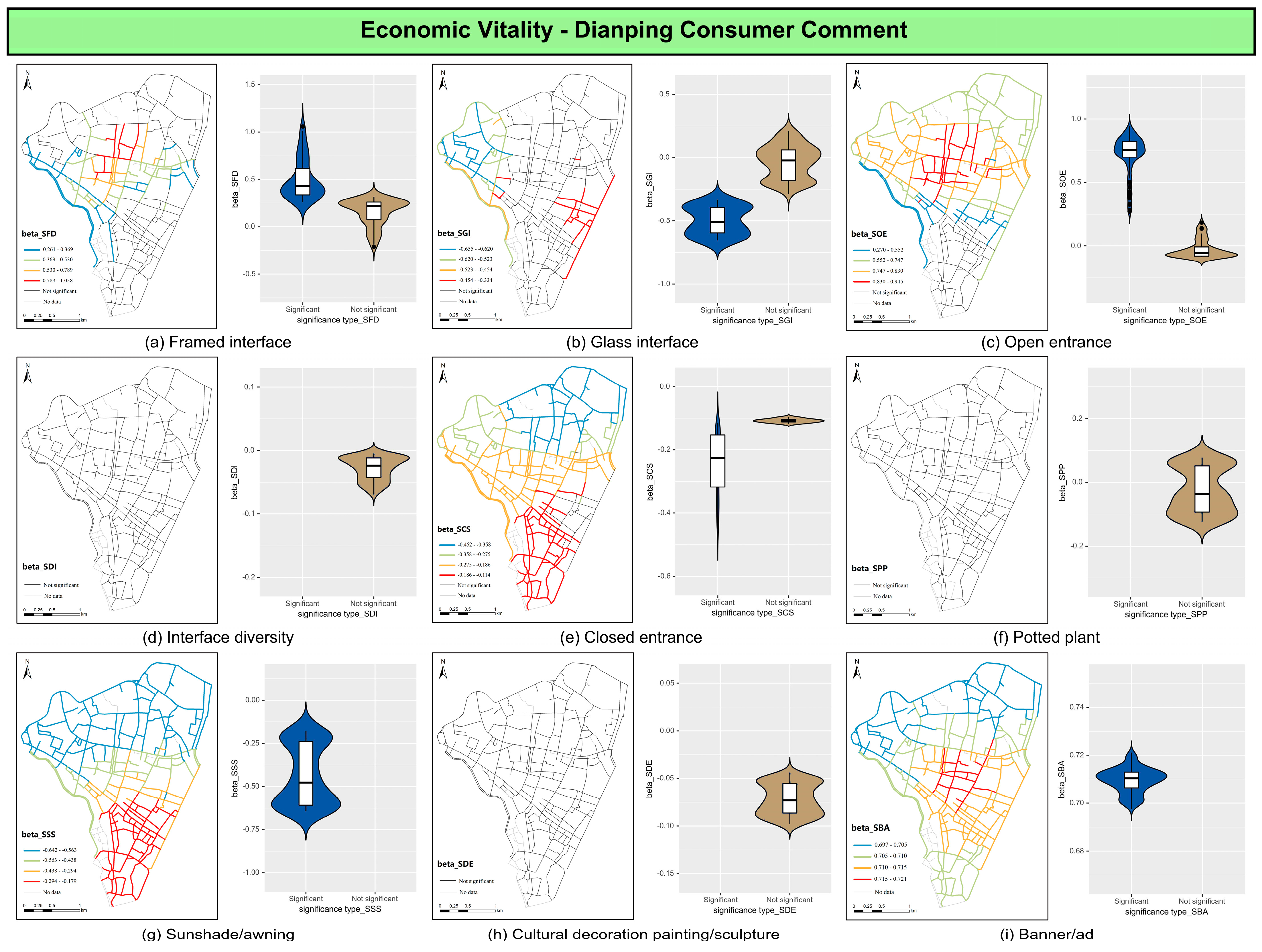

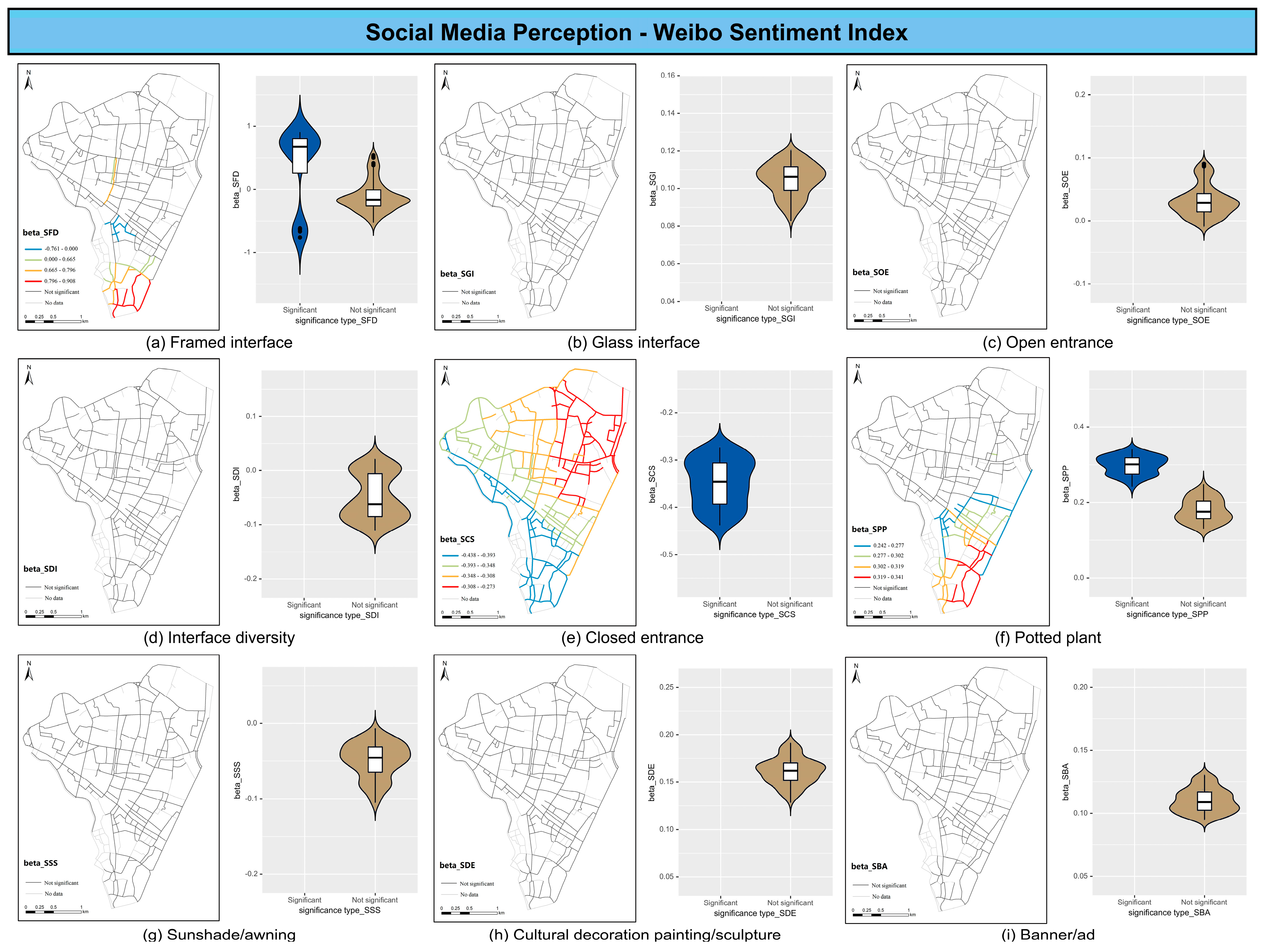
| Study Area | Image Data | Selected Streetscape Element | Algorithm | Source |
|---|---|---|---|---|
| 56 global cities | Google Street View | Wall, building, road, sidewalk, fence, signboard, path, stairs, door, bench, awning, streetlight, pole, fountain, sculpture, traffic light, stairway, tree, grass, plant, water, waterfall, lake, mountain, rock | PSPNet | [16] |
| Shenzhen, China | Tencent Street View | Greenspace vegetation (tree, forest, greenbelt, lawn), building, sky, wall, road, pavement | SegNet | [21] |
| Guangzhou, China | Tencent Street View | Street furniture (fences, streetlights, traffic lights, cameras, windows), pedestrian, bicycle, booth, trade name, signboard, pavement, roadway, motor vehicles | FCN | [35] |
| Shanghai, China | Baidu Street View | Sky, building, tree, road, pavement, fence, sign, vehicle, pedestrian, bike | SegNet | [36] |
| Xuzhou, China | Baidu Street View | Signboard, frame door, glass interface, open store, closed store | YOLO | [11] |
| Atlanta, GA, USA | Google Street View | Building, house, sidewalk, road, car, tree, plant, grass, walk signal, crosswalk, sidewalk, buffer, streetlight | PSPNet | [37] |
| Seoul, Korea | Naver Street View | Building, tree, plant, sky, road, sidewalk, street furniture | High-resolution networks; Canny Edge | [38] |
| Seoul, Korea | Google Street View | Vegetation, building, road, sidewalk | Deeplab V3+ | [39] |
| ZG city, China | Baidu Street View | Wall, building, tree, road, window, grass, plant, sidewalk, fence | Faster R-CNN; PSPNet | [40] |
| Type | Subtype | Label Code | Definition |
|---|---|---|---|
| Basic | Framed door/window | Framedoor | (1) There are clear horizontal and vertical frames inside the outline of doors and windows; (2) an interface mainly used by the storefronts operating indoors, with relatively poor display quality. |
| Glass gateway/window | Glassinterface | (1) Glass occupying the main part of the gateways or windows, with no frame inside; (2) an interface mainly used by the storefronts needing to be displayed externally. | |
| Open entrance | Openentry | (1) Only the outlines of entrances can be seen, with shadows or various goods in them; (2) an interface of the storefronts that require direct and constant outdoor activities. | |
| Closed entrance | Closedstore | (1) Storefronts that are shut down or not in business; (2) a special component of the streetscape that can reflect urban economies and the experience of street vitality. | |
| Commercial | Store signboard | Signboard | (1) A reflection of street economic vitality and the number of storefronts, whether in business or not; (2) usually fixed above entrance interfaces. |
| Banner/ad | Banner | (1) Larger quantity and smaller scale compared to store signboards; (2) generally used at the height of the visual level or lower. | |
| Movable | Sunshade/awning | Sunshade | (1) It mainly serves to shield against wind, rain, and sunlight, and also indicates a certain outdoor usage range; (2) usually located at a higher position than doors and windows and close to the vertical interfaces of storefronts. |
| Outdoor umbrella | Umbrella | (1) Commonly used by street vendors, or storefronts to set up stalls and outdoor businesses along the street. | |
| Potted plant | Pottedplant | (1) A kind of private greenery for store decoration and embellishment of natural elements; (2) usually placed at entrances. | |
| Cultural | Wall decoration painting/sculpture | Decoration | (1) Generally, hard materials, such as bricks and stones, are used with clear outlines; (2) a cultural element usually placed at vertical interfaces or independently near entrances. |
| Variables | Abbr. | Description | Calculation Method |
|---|---|---|---|
| Dependent variables | |||
| Online economic vitality index | DMQ | The quantity of the Dianping merchants in a unit | Buffer creation and the spatial connection tool in overlay analysis in ArcGIS |
| DCC | The sum of the Dianping consumer comments in a unit | Buffer creation and the spatial connection tool in overlay analysis in ArcGIS | |
| Social media perception index | WCQ | The quantity of the Weibo check-in records in a unit | Buffer creation and the spatial connection tool in overlay analysis in ArcGIS |
| WSI | The average sentiment index of Weibo texts in a unit | where confiw and prob_piw are obtained from the Baidu Natural Language Processing (NLP) API, and stand for the confidence level and positive sentiment probability of the w-th Weibo text in the i-th unit, respectively. | |
| Independent variables | |||
| Basic interface usage | SFD | The sum of the framed doors and windows in a unit | SFDi = FDli + FDri where FDli and FDri are the sums of the framed doors and windows of the i-th unit from the L- and R-side, respectively. |
| SGI | The sum of the glass gateways and windows in a unit | SGIi = GIli + GIri where GIli and GIri are the sums of the glass gateways and windows of the i-th unit from the L- and R-side, respectively. | |
| SOE | The sum of the open entrances in a unit | SOEi = OEli + OEri where OEli and OEri are the sums of the open entrances of the i-th unit from the L- and R-side, respectively. | |
| SCS | The sum of the closed entrances in a unit | SCSi = CSli + CSri where CSli and CSri are the sums of the closed entrances of the i-th unit from the L- and R-side, respectively. | |
| Interface diversity index | SDI | The interface diversity degree of the storefronts in business calculated by Shannon entropy | where Pj is the proportion of the j-th type of the interfaces from operating storefronts within the i-th unit. |
| Commercial element usage | SSB | The sum of the store signboards in a unit | SSBi = SBli + SBri where SBli and SBri are the sums of the store signboards of the i-th unit from the L- and R-side, respectively. |
| SBA | The sum of the banners and ads in a unit | SBAi = BAli + BAri where BAli and BAri are the sums of the banners and ads of the i-th unit from the L- and R-side, respectively. | |
| Movable element usage | SSS | The sum of the sunshades and awnings in a unit | SSSi = SSli + SSri where SSli and SSri are the sums of the sunshades and awnings of the i-th unit from the L- and R-side, respectively. |
| SPP | The sum of the potted plants in a unit | SPPi = PPli + PPri where PPli and PPri are the sums of the potted plants of the i-th unit from the L- and R-side, respectively. | |
| Cultural element usage | SDE | The sum of the wall decoration paintings and sculptures in a unit | SDEi = DEli + DEri where DEli and DEri are the sums of the cultural decoration paintings and sculptures of the i-th unit from the L- and R-side, respectively. |
| Social Sensing Index | R2 | Adjusted R2 | Durbin-Watson Value |
|---|---|---|---|
| DMQ | 0.439 | 0.406 | 1.976 |
| DCC | 0.463 | 0.431 | 2.119 |
| WCQ | 0.255 | 0.201 | 2.076 |
| WSI | 0.183 | 0.124 | 1.949 |
| Social Sensing Index | GWR | MGWR | ||||
|---|---|---|---|---|---|---|
| R2 | Adjusted R2 | AIC | R2 | Adjusted R2 | AIC | |
| DMQ | 0.786 | 0.709 | 300.633 | 0.800 | 0.744 | 274.549 |
| DCC | 0.819 | 0.746 | 281.044 | 0.812 | 0.755 | 268.980 |
| WCQ | 0.377 | 0.271 | 357.567 | 0.502 | 0.374 | 343.209 |
| WSI | 0.245 | 0.134 | 378.724 | 0.364 | 0.242 | 364.564 |
Disclaimer/Publisher’s Note: The statements, opinions and data contained in all publications are solely those of the individual author(s) and contributor(s) and not of MDPI and/or the editor(s). MDPI and/or the editor(s) disclaim responsibility for any injury to people or property resulting from any ideas, methods, instructions or products referred to in the content. |
© 2025 by the authors. Licensee MDPI, Basel, Switzerland. This article is an open access article distributed under the terms and conditions of the Creative Commons Attribution (CC BY) license (https://creativecommons.org/licenses/by/4.0/).
Share and Cite
Li, K.; Lin, Y. Mapping the Impact of Spontaneous Streetscape Features on Social Sensing in the Old City of Quanzhou, China: Based on Multisource Data and Machine Learning. Buildings 2025, 15, 1522. https://doi.org/10.3390/buildings15091522
Li K, Lin Y. Mapping the Impact of Spontaneous Streetscape Features on Social Sensing in the Old City of Quanzhou, China: Based on Multisource Data and Machine Learning. Buildings. 2025; 15(9):1522. https://doi.org/10.3390/buildings15091522
Chicago/Turabian StyleLi, Keran, and Yan Lin. 2025. "Mapping the Impact of Spontaneous Streetscape Features on Social Sensing in the Old City of Quanzhou, China: Based on Multisource Data and Machine Learning" Buildings 15, no. 9: 1522. https://doi.org/10.3390/buildings15091522
APA StyleLi, K., & Lin, Y. (2025). Mapping the Impact of Spontaneous Streetscape Features on Social Sensing in the Old City of Quanzhou, China: Based on Multisource Data and Machine Learning. Buildings, 15(9), 1522. https://doi.org/10.3390/buildings15091522






